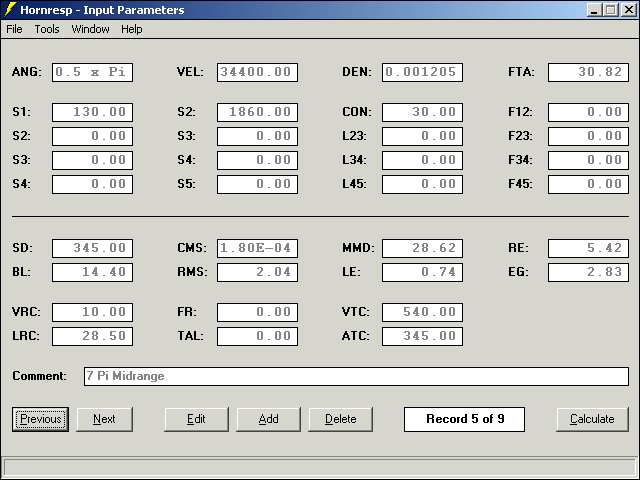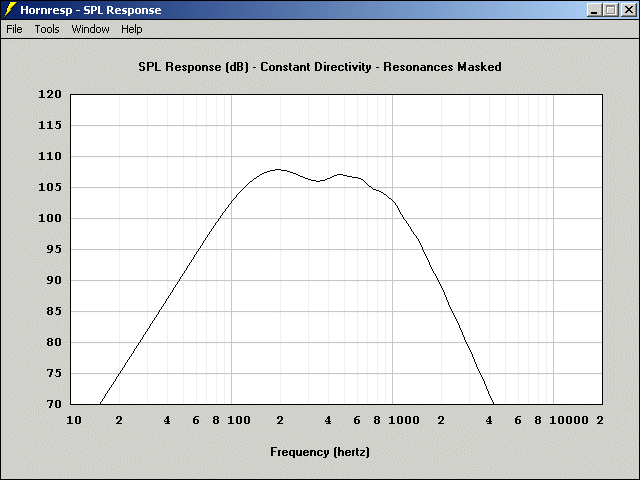| Midhorn Input Data [message #50243] |
Sat, 11 November 2006 15:52  |
 Cuppa Joe
Cuppa Joe
Messages: 103
Registered: May 2009
|
Viscount |
|
|
Hi, Wayne! Since I'm playing around with HornResp for the first time ever, I thought it would be a good idea to have an accurate reference point against which I could compare my early modeling calculations. I would be honored if your Midhorn were that reference, as my focus of interest is in a conical midrange/midbass device. So, I was wondering if you still had the original HornResp Input Parameters for it?
|
|
|
|
| Hornresp models [message #50245 is a reply to message #50243] |
Sat, 11 November 2006 19:43   |
 |
 Wayne Parham
Wayne Parham
Messages: 18985
Registered: January 2001
|
Illuminati (33rd Degree) |
|
|
Here's the Hornresp input file, simulated response and actual measured response of a π midhorn using a JBL 2012 driver. You'll notice they correlate well, but at high frequencies, there are some peaks that don't show up in the model. That's because of cone breakup. The model calculates assuming a rigid piston cone, but at high frequencies, the cone starts to vibrate along its surface. That means parts of the surface are decoupled from others, effectively acting like several smaller cones having lighter mass. Hornresp input data for π midhorn with JBL 2012 driver Hornresp input data for π midhorn with JBL 2012 driver
 Hornresp simulated response for π midhorn with JBL 2012 driver Hornresp simulated response for π midhorn with JBL 2012 driver
 Measured response of π midhorn with JBL 2012 driver Measured response of π midhorn with JBL 2012 driver
If you're studying Hornresp, you might model some folded basshorns. The folds tend to attenuate HF, so cone breakup is rolled off. Because of that, measurements of folded horns tend to agree quite well with models. See the models of the 12π basshorn subwoofer, for example. 12π basshorn model
Effects of changing 12π horn front chamber volume
|
|
|
|
| Re: Hornresp models [message #50246 is a reply to message #50245] |
Sat, 11 November 2006 22:15   |
 Cuppa Joe
Cuppa Joe
Messages: 103
Registered: May 2009
|
Viscount |
|
|
|
Thanks, Wayne! I was close for much of the input, but I modeled the horn in free space, while merely guessing at the VTC. The T/S look more like the Delta 10, though (preferred for its availability). Does the VTC in your model include the 1/4" spacer, and does the axial length include the throat depth? Is there any universal advantage to modeling in 1/8th space? If a design is intended for live SR, I'm thinking that 4xPi would be more realistic, as it would be the worst-case scenario for any venue setup. I'm not up to trying a basshorn just yet! The Midhorn is challenge enough for a beginner, and the Input Parameter page still resembles a Greek crossword puzzle....
|
|
|
|
|
|
| Re: Hornresp models [message #50252 is a reply to message #50247] |
Sun, 12 November 2006 14:11   |
 Cuppa Joe
Cuppa Joe
Messages: 103
Registered: May 2009
|
Viscount |
|
|
|
Yes, I had played around with expanding the horn in an attempt to move the LF rolloff as close to 160Hz as possible (the highest compromise I'll tolerate for X-over to a dedicated sub), and wound up with a mouth of 30.5" x 15.5", but with only 13" of depth. Shouldn't I need 21.25" of depth for 1/4 WL of 160Hz? The trouble with a 90-degree horn is that the mouth widens 2" for every 1" of depth added. The rest of the fantasy was to coaxially mount the HF section inside the midhorn's mouth, using a pair of up-ended, trim'n'glue P.Audio PH2510 horns to create an unbroken vertical array to the next midhorn/high pak. Voila, vertical line array!
|
|
|
|
|
|
|
|
|
|
| Re: Hornresp models [message #50274 is a reply to message #50264] |
Thu, 16 November 2006 23:37   |
 Cuppa Joe
Cuppa Joe
Messages: 103
Registered: May 2009
|
Viscount |
|
|
|
I don't see the 9Pi on your website. Is it not yet ready to unveil? I was curious about the true upper cutoff of the 15" midbass horn, since HornResp tends to graph an earlier rolloff (or so I'm told). Is there a set ratio between HornResp and real-world measurements, or is the difference more design specific?
|
|
|
|
| Re: Hornresp models [message #50277 is a reply to message #50274] |
Sat, 18 November 2006 10:18   |
 |
 Wayne Parham
Wayne Parham
Messages: 18985
Registered: January 2001
|
Illuminati (33rd Degree) |
|
|
The 9π design isn't done yet. Individual parts are finished, but layout and testing isn't.As for the differences between Hornresp models and measured response, the biggest difference is caused by cone breakup modes. Folded basshorns have close agreement with measurements because their folds and large front chambers attenuate output from breakup modes. Smaller midbass and midrange horns don't have these features, so output from breakup modes passes through them. In most cases, a crossover is used to prevent frequencies that would excite a speaker's breakup modes. In other cases, a speaker is chosen with damped and well behaved breakup modes to extend response. Hornresp models assume rigid piston motion from the driver. When the cone enters breakup, regions of the cone vibrate independently of the rest of the cone. Ripples develop along its surface and each part acts like a smaller, lighter membrane with a stiff suspension between it and an adjacent node. So it sort of acts like an array of lightweight cones driving the horn. This creates extended response, but since the nodes are formed like ripples on a pond, their position moves with respect to frequency. Standing wave patterns develop along the cone, with some frequencies much louder than others. The net effect is that breakup mode output is usually pretty ragged and peaky. Sometimes it's usable, sometimes not.
|
|
|
|







